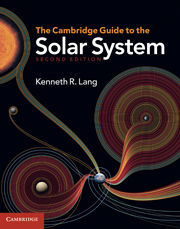Book contents
- Frontmatter
- Contents
- List of focus elements
- List of tables
- Preface to the second edition
- Preface to the first edition
- Principal units
- Part 1 Changing views and fundamental concepts
- Part 2 The inner solar system: rocky worlds
- Part 3 The giant planets, their satellites and their rings: worlds of liquid, ice and gas
- Part 4 Remnants of creation: small worlds in the solar system
- Part 5 Origin of the solar system and extrasolar planets
- 16 Brave new worlds
- Author index
- Subject index
16 - Brave new worlds
from Part 5 - Origin of the solar system and extrasolar planets
Published online by Cambridge University Press: 05 August 2011
- Frontmatter
- Contents
- List of focus elements
- List of tables
- Preface to the second edition
- Preface to the first edition
- Principal units
- Part 1 Changing views and fundamental concepts
- Part 2 The inner solar system: rocky worlds
- Part 3 The giant planets, their satellites and their rings: worlds of liquid, ice and gas
- Part 4 Remnants of creation: small worlds in the solar system
- Part 5 Origin of the solar system and extrasolar planets
- 16 Brave new worlds
- Author index
- Subject index
Summary
• According to the nebular hypothesis, the Sun and planets formed out of a single collapsing, rotating cloud of interstellar gas and dust called the solar nebula. This hypothesis provides a natural explanation for the highly regular pattern of the planet and satellite orbits.
• Conservation of angular momentum in gravitational collapse suggests that the Sun initially rotated much more rapidly than it does now.
• Spiral nebulae were once thought to be young stars enveloped by nascent planetary systems, but they are now known to be distant galaxies, each containing roughly 100 billion stars.
• The youngest stars in our Milky Way Galaxy are surrounded by dusty planet-forming disks, initially discovered by their infrared radiation, and detected in large numbers and great detail by the Hubble Space Telescope and the Spitzer Space Telescope.
• Vast interstellar clouds of gas and dust are the incubators of large numbers of newborn stars, many of them embedded in the material from which they arose and surrounded by flattened, rotating planet-forming disks.
• At least two planets with a mass comparable to that of the Earth were discovered orbiting a cold, dark pulsar.
• The first unseen planets circling ordinary Sun-like stars were inferred from the tiny, periodic Doppler wavelength shifts of their parent star's spectral lines, caused by the motion of the orbiting planet. They became known as “hot Jupiters”, since they revolve unexpectedly close to their star and have masses comparable to that of Jupiter. […]
- Type
- Chapter
- Information
- The Cambridge Guide to the Solar System , pp. 445 - 460Publisher: Cambridge University PressPrint publication year: 2011



